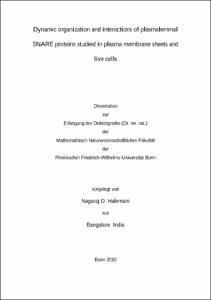Halemani, Nagaraj D.: Dynamic organization and interactions of plasmalemmal SNARE proteins studied in plasma membrane sheets and live cells. - Bonn, 2012. - Dissertation, Rheinische Friedrich-Wilhelms-Universität Bonn.
Online-Ausgabe in bonndoc: https://nbn-resolving.org/urn:nbn:de:hbz:5n-28079
Online-Ausgabe in bonndoc: https://nbn-resolving.org/urn:nbn:de:hbz:5n-28079
@phdthesis{handle:20.500.11811/5292,
urn: https://nbn-resolving.org/urn:nbn:de:hbz:5n-28079,
author = {{Nagaraj D. Halemani}},
title = {Dynamic organization and interactions of plasmalemmal SNARE proteins studied in plasma membrane sheets and live cells},
school = {Rheinische Friedrich-Wilhelms-Universität Bonn},
year = 2012,
month = apr,
note = {All Eukaryotic cells and their internal organelles are surrounded by membranes. Many cellular functions involve transport of material between membrane bound compartments initiated by a fusion step of respective membranes. One example is regulated exocytosis during which cellular secretion at the plasma membrane is spatially restricted and temporally controlled. This complex process requires a multitude of molecular players, for instance, neuronal SNARE (Soluble N-ethylmaleimide-sensitive-factor Attachment Receptor) proteins, namely, SNAP-25 and syntaxin 1 on the pre-synaptic membrane and synaptobrevin from the vesicular membrane. All three SNARE proteins come together to form a four helical bundle to drive the fusion of two opposing membranes and thereby mediate the release of vesicular contents into the synaptic cleft.
Assembly of SNARE proteins occurs in a sequential manner, beginning with the formation of an initial intermediate involving interaction between the plasma membrane SNAREs, SNAP-25 and syntaxin 1. A wide variety of studies have reported a possible set of initial intermediate complexes regulated by accessory proteins. But the exact nature of the physiological intermediates in the SNARE assembly pathway has been elusive.
In this work, the existence of such initial intermediates has been studied – FRAP (Fluorescence Recovery After Photobleaching) has been applied to study protein interactions in live cells complemented by biochemical studies using plasma membrane sheets and analysis of their spatial organization by super resolution microscopy. In addition, it has been tested how divalent cations influence the organization of membrane proteins. The two SNARE proteins, SNAP-25 and syntaxin 1, known to be organized into separate clusters, were found to be subjected to regulation by non specific electrostatic interactions mediated by the divalent cation calcium. More importantly, the neuronal SNAREs syntaxin 1 and SNAP-25 interact at the interface of their respective protein clusters to form an initial intermediate, involving only the N-terminal SNARE motif of SNAP-25 and SNARE motif of syntaxin 1, independent of any neuronal co-factors. The intermediate complex seems to be fully zippered all along the SNARE motifs and highly dependent on the position and orientation of the SNARE motifs involved.
The observed complex is different from the ones reported by numerous in vitro studies. The existence of such an intermediate complex in live cells is a consequence of specific organization of the two SNARE proteins into clusters on the plasma membrane with different mechanisms which results in an excess of active SNAP-25 relative to syntaxin 1.
Our study highlights the importance of studying membrane proteins and their interactions in their native environment as the membrane seems to exert a multi component regulation on its constituent proteins.},
url = {https://hdl.handle.net/20.500.11811/5292}
}
urn: https://nbn-resolving.org/urn:nbn:de:hbz:5n-28079,
author = {{Nagaraj D. Halemani}},
title = {Dynamic organization and interactions of plasmalemmal SNARE proteins studied in plasma membrane sheets and live cells},
school = {Rheinische Friedrich-Wilhelms-Universität Bonn},
year = 2012,
month = apr,
note = {All Eukaryotic cells and their internal organelles are surrounded by membranes. Many cellular functions involve transport of material between membrane bound compartments initiated by a fusion step of respective membranes. One example is regulated exocytosis during which cellular secretion at the plasma membrane is spatially restricted and temporally controlled. This complex process requires a multitude of molecular players, for instance, neuronal SNARE (Soluble N-ethylmaleimide-sensitive-factor Attachment Receptor) proteins, namely, SNAP-25 and syntaxin 1 on the pre-synaptic membrane and synaptobrevin from the vesicular membrane. All three SNARE proteins come together to form a four helical bundle to drive the fusion of two opposing membranes and thereby mediate the release of vesicular contents into the synaptic cleft.
Assembly of SNARE proteins occurs in a sequential manner, beginning with the formation of an initial intermediate involving interaction between the plasma membrane SNAREs, SNAP-25 and syntaxin 1. A wide variety of studies have reported a possible set of initial intermediate complexes regulated by accessory proteins. But the exact nature of the physiological intermediates in the SNARE assembly pathway has been elusive.
In this work, the existence of such initial intermediates has been studied – FRAP (Fluorescence Recovery After Photobleaching) has been applied to study protein interactions in live cells complemented by biochemical studies using plasma membrane sheets and analysis of their spatial organization by super resolution microscopy. In addition, it has been tested how divalent cations influence the organization of membrane proteins. The two SNARE proteins, SNAP-25 and syntaxin 1, known to be organized into separate clusters, were found to be subjected to regulation by non specific electrostatic interactions mediated by the divalent cation calcium. More importantly, the neuronal SNAREs syntaxin 1 and SNAP-25 interact at the interface of their respective protein clusters to form an initial intermediate, involving only the N-terminal SNARE motif of SNAP-25 and SNARE motif of syntaxin 1, independent of any neuronal co-factors. The intermediate complex seems to be fully zippered all along the SNARE motifs and highly dependent on the position and orientation of the SNARE motifs involved.
The observed complex is different from the ones reported by numerous in vitro studies. The existence of such an intermediate complex in live cells is a consequence of specific organization of the two SNARE proteins into clusters on the plasma membrane with different mechanisms which results in an excess of active SNAP-25 relative to syntaxin 1.
Our study highlights the importance of studying membrane proteins and their interactions in their native environment as the membrane seems to exert a multi component regulation on its constituent proteins.},
url = {https://hdl.handle.net/20.500.11811/5292}
}






